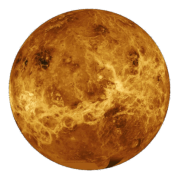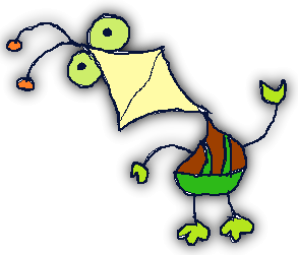Watch ‘Voyage to the Planets’ parts 1 and 2
Venus is, in many respects, the twin of Earth. These outward similarities led some to believe that
Venus was a hospitable planet, where jungles and dinosaurs could be found. Sci Fi magazines featured
interesting covers illustrating the stories inside. We sure made some very odd movies about Venus. But, a
closer look at Venus shows that it is in no way an identical twin of Earth. The conditions on its surface are
brutal! The atmospheric pressure at the surface is ninety times greater than Earth’s and the surface temperature
hovers at about 730 Kelvin (457 Celsius) most of the time. There has never been a break in the clouds of Venus which rain
down sulfuric acid to near the surface as virga. With no plate tectonics, most of the surface is similar to the basaltic floors of
Earth’s oceans, but without the water. A global map of the topography shows little change in elevation. For reference, here’s
a look at Earth’s topography.
A number of space probes from the former Soviet Union and the United States have gathered data which give us an
entirely different view of Venus. We have hundreds of images from these probes. All of which show a barren and inhospitable
surface.



The radius of Venus is 6,052 kilometers, which is
only slightly less than Earth's. This smaller size,
along with slightly less mass makes the surface
gravity of Venus 90% of Earth's. If you walked
around on the surface, you might not notice the
difference.
First of all, Venus rotates backward, or retrograde, unlike
any of the other terrestrial planets. It take 243 days to
spin once, which is sometimes expressed as -243 days.
The time from noon to noon, or the synodic day, is 117 of
our Earth days.
Venus' orbit is a little less than 3/4 of the size of Earth's. It
orbits the Sun in just about 225 of our days. That would
be the length of the year on Venus. Venus' orbit is one of
the most circular in the solar system with an eccentricity
of only 0.0067.
The atmosphere of Venus does not smell very good. It is
95% carbon dioxide, and a few percent nitrogen. But it is
the sulfur dioxide which gives the planets its wonderful
rotten egg smell. The pressure at the surface is 92 bars
with just the slightest wind.
Of course Venus has clouds! There’s always
clouds on Venus. We have never seen the surface
from Earth. We believe there is a level in the
clouds which is about eaqual to Earth’s
atmospheric pressure and temperature. Perhaps
we could float there in a big balloon and explore
the planet from above.
Venus has no moons. Although discovering one
might be Neith.


















































